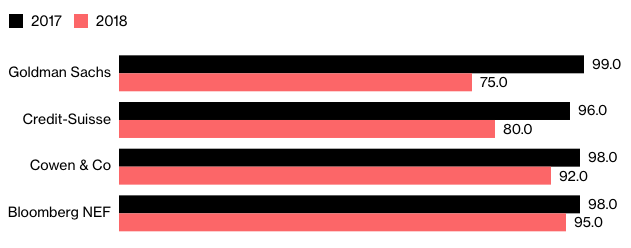Forecasters are in agreement that the solar panel market will contract this year, with estimates ranging from 3 to 24 percent. The decline in the solar market is due to China suspending approvals for new installations and cutting subsidies to solar power, as well as the Trump administration’s 30-percent import tariff on Chinese-made solar photovoltaic (PV) panels. In late May, China pulled the plug on about 20 gigawatts of its utility-scale solar projects, reducing global installations to 75 gigawatts in 2018, down from 99 gigawatts in 2017, according to Goldman Sachs.
Goldman Sachs projected that the solar panel market will contract by 24 percent this year, with an estimated 40-percent drop in sales volumes in China. Credit Suisse predicted a lower 17-percent reduction. Bloomberg New Energy Finance (BNEF) predicted that the solar market will contract by 3 percent under a conservative scenario, indicating a PV panel glut globally. But BNEF also projected that the glut will lower prices and stimulate demand, which will eventually reverse the downturn, allowing the market to recover as soon as next year.
The more panels there are on the global market, the lower their prices, and the lower the prices, the more attractive the technology would be. Also, the lower prices will help mitigate the impact of the tariffs on the U.S. solar industry, although they cannot offset them completely. BNEF expects China’s role in the global solar market to decline in the medium term, accounting for 25 percent of new installations in 2020, down from over half in 2017. Japan, on the other hand, may help to keep solar installations up through its feed-in tariffs to projects under 2 megawatts.
Global Solar Installations Contract in 4 Forecasts (In Gigawatts)

Despite China’s expected lower installations this year, Asia is still expected to continue to account for at least 50 percent of the global annual installations through 2020, according to GTM Research. Other regions such as North America and Europe are expected to account for 16 percent and 12 percent of installations, respectively, through 2023. Latin America is expected to account for an average of 7 percent of global installations through 2023 with Mexico, Brazil, and Chile accounting for 81 percent of the region’s capacity additions.
New Solar Markets
The Middle East, an emerging market, is expected to triple its share of global installed capacity from 3 percent in 2018 to 9 percent in 2023, driven by Saudi Arabia and the United Arab Emirates, which are expected to account for 50 percent of the regional capacity additions through 2023.
A survey found that the Saudi solar market could expand at a compound annual rate of 30 percent between 2018 and 2024. Additionally, the Saudi government allocated $7 billion for the development of renewable energy projects in its FY2019 budget. The United Arab Emirates is planning to source a quarter of its energy from renewable energy by 2030 and China’s Silk Road Fund is helping to support a large solar plant there.
Africa is another market that could become an emerging force in solar power. Sub-Saharan Africa has a number of support mechanisms backed by development banks that are driving significant projects in a number of countries. The most widely publicized support is the World Bank’s “Scaling Solar” program, led by the International Finance Corporation, which has provided for the largest scale projects in sub-Saharan Africa.
Conclusion
China has been the leader of solar panel installations for several years. But global solar panel installations are expected to shrink as China cuts subsidies to its solar industry. While other markets are emerging, forecasters expect global solar installations will be down this year and that will continue until the market adjusts to new prices that are expected to be lower as a glut of solar panels hits the market.



